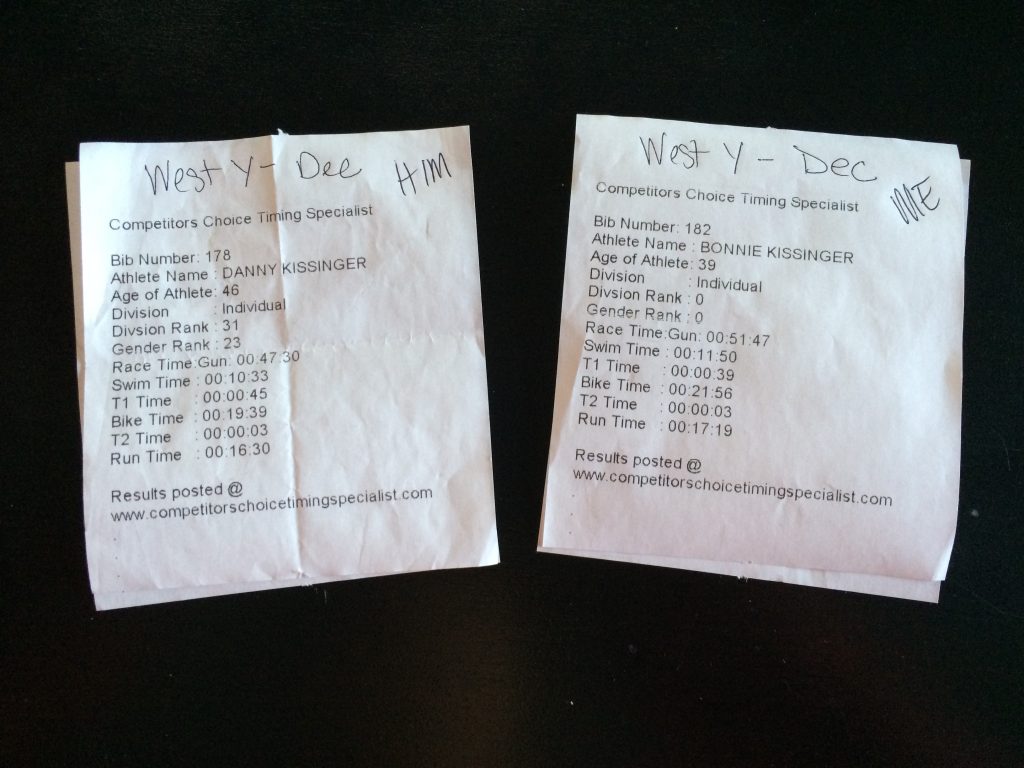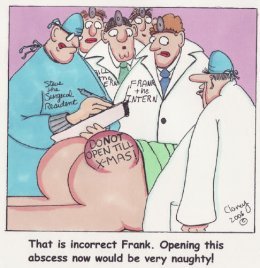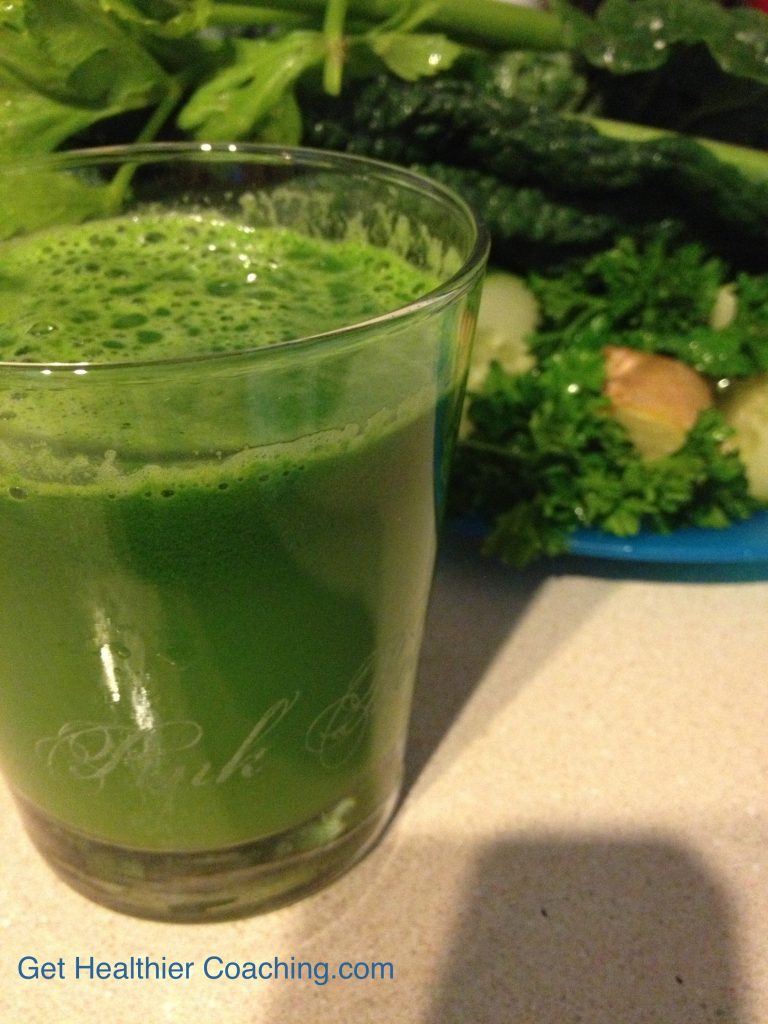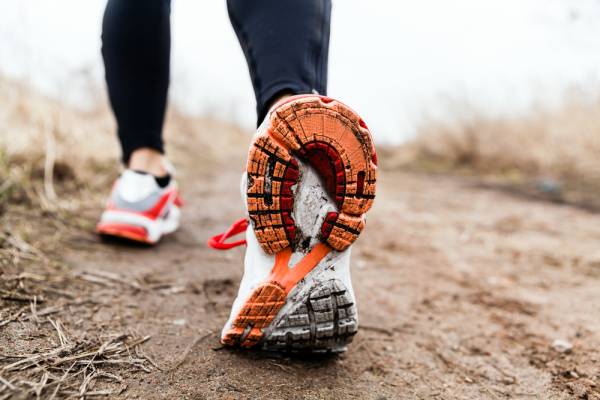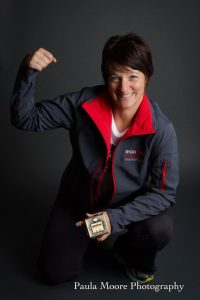 Hearing those words as you run down the shoot… it’s an indescribable experience. It’s like an orgasm, but way better!
Hearing those words as you run down the shoot… it’s an indescribable experience. It’s like an orgasm, but way better!
It starts about .2 miles out. It’s getting crowded. You can FEEL the finish. Your body forgets it is tired. It’s not that you want to be done. That you need to be done. You are CHARGED UP!
You see hundreds of strangers cheering you on…and AT THAT MOMENT they aren’t strangers. You hear the voices of your teammates screaming their heads off for you. They love you and are so proud of you. The volunteers and athletes there cheering you on, knowing the countless hours, tears and sacrifices that you made.
The eyes that you see filled with joy.
The smiles that are beaming at you.
The hands that you HI FIVE.
The voice of Mike Reily
The music.
You are being drawn down the finishing chute as if you’re in the channel of a powerful river. You’re not just finishing a race, it’s…
HELL YEAH. THIS MOMENT IS MINE!
Once upon a time…
My Ironman journey started almost two years ago when I decided I wanted to learn how to surf. It dawned on me that I’d kill myself because I was afraid of the water, still held my nose when I jumped in. I couldn’t swim. I had a near drowning experience when I was 8. My son did as well when he was 5. So I left a message with a swim coach. Heidi Coble called me back.
The swim has been a hard go for me. Panic. Anxiety. Asthma. It’s humbling (and scary) to have an asthma attack in the lake and have to be hauled in. It’s disheartening to have the Kansas 70.3 swim thrown at you repeatedly and you meet the challenge with FREAK OUT. Being afraid of that damn swim. Many many tears. Of struggle. Of frustration. Of letting things go. Learning to swim in chop. Learning to swim in chop breathing to your weak side. Learning to swim dealing with your asthma attacks. Hard stuff. I got through most of my swim “issues” during the 2012 triathlon season. I was still crazy slow and unsure of myself, but I think my coaches weren’t constantly worried that I’d get out of the water.
dropping off the dough…
So when I found myself in the Lovgren car traveling up to Wisconsin to volunteer/sign up for IMWI 2013, I was completely freaking out. And trying to ignore it. Watching the Ironman race swim start…it was incredible. Those brave and fantastically awesome people. Crying as I watched the swim cut off, those brave and fantastic people that didn’t make it… on the anxiety meter, I was maxed out. The mass swim start was so beautiful and badass. I said to myself, “I WANT TO DO THAT!” Riding the bike course the day before the race was great. It was hard. But it told me what I was in for!
I’m signed up…
and then I got injured. I tore up my AC joint digging a hole. I jacked up my leg/knee in an adventure race. I started off-season training visiting Dr. Jon Messenger, ART specialist and chiropractor, every week. Big fat thank you to Dr. M. Without his expertise, skill at listening and team work approach, I am sure my shoulder and knee wouldn’t be in the great/better shape they are now.
OFF SEASON: TIME TO GET TO WORK
REHAB. So no yoga (because I’m a bad girl and wouldn’t stop doing the fun stuff). No running. Pool swimming was all therapeutic. Which was a blessing, as I was forced to focus on the basics and get some things right. Or else my shoulder would hurt like hell. HA! There were times I could barely lift myself out of the pool. That sucked. Good thing my coaches are patient ones! It was incredibly frustrating. Many times pools swims ended early. I’d be mad. I’d cry walking back to the locker…I was a complete wreck. I won’t go into all the emotional BS that I dillie-dallied with (I wrote it. I read it. Though to myself, OMG, it’s a wonder my coaches let me come to practice. I was a complete whiner. I deleted it).
LESSON: Pain is your body communicating to you. Don’t ignore it.
LESSON: Sometimes injuries are fleeting, so don’t freak out. There are a ton of things to do to fix it up right quick (learned later)!
LESSON: Don’t be so dramatic. Don’t be so hard on yourself. Chill out. You have time. Trust your coach (learned much later).
SEASON STARTS:
I started to get to work. I learned how to work with my body. I studied the nutrition piece. I focused on balance. I had to focus on keeping my needy body parts happy. Were things smooth sailing? No flippin’ way.
McKinney Sprint Triathlon. Asthma kicked my tale. More crying. The damn weather wouldn’t play nice so Kansas 70.3 was a “strip the band-aide off” kind of swim. I horsed around for a good 20 minutes before I got into a rhythm that would resemble swimming. Won’t go into all the details…but Kansas 70.3 was a turning point for me. Coach Jeff and I had a talk. Basically … “you need to get your shit together”. I was really busy: going to school to be a health coach, schooling my own kids, trying to work, build a business, blah blah blah. Kansas 70.3 sucked big time and none of the latter was really the issue, it was mental BS.
LESSON: Focus on what matters most.
Oh yeah. Kansas 70.3 was the start of left shin splint.
Two months later, Boulder 70.3: I rocked it. This was the big turning point for me, for the swim. For a lot of things. A month from Wisconsin Ironman. I felt… “just about ready.”
Update on shin splint. Getting worse. Not doing a lot of running the last month before Wisconsin. Again at Dr. M’s constantly. Cold laser therapy. Normatec. PT. Oil applications. Dr M and I had this conversation… “what happens if this flares up during the race and I just ignore it, will I end up with screws in my leg”. Always good sound advice from the Dr M.
LESSON: What to do with the different levels of pain and discomfort. Continue adding up the miles because you’ve never ran a marathon or stop and rest to save yourself for the race. Hard lesson.
Playing around on Facebook, especially the Ironman Wisconsin group, was AWESOME too. Made some awesome friends! You all are the BEST!
PRE RACE: TWO WEEKS
I spent a lot of time mentally preparing. Yoga nidra, visualizing, meditating. And I mastered the art of controlled freaking out. I think others around me didn’t think so but… it all payed off.
I was really freaked about the bike, I wasn’t completely confident that I could get it done. It was strange though…I was really focused on the swim. I wanted to experience the swim with NO freaking out. In control all the time. So I focused on that and did my best to ignore all the doubts I had about the bike. And fear that my injuries would be loud on the run.
I had piles of race stuff everywhere in the bedroom. I never intended to be a beggar, but I ended up borrowing a lot of stuff. Next year I’ll try and race with all my own stuff! I was planning. Visualizing. Thinking. My husband attempted to come in one day. I said “This might not be the safest place for you right now.” He was always so gracious. “Ok babe.” Or just turning around without saying much. I ordered tri tats so my race numbers would be pretty. Super glad I did. I wrote action steps for T1 and T2 to put in my transition bags. I had been training with Endurafuel after Kansas 70.3. Which was a great change. So I obsessed about the smartest way to fuel myself on the bike and run. I’m glad I did because I was very well prepared mentally on race day. I guess I had freaked out enough during the two weeks before the race that I was completely chill race day.
THE DAYS BEFORE WISCONSIN
Traveling up to Wisconsin was fun and interesting. I loved getting up there early. It was nice to take in the scenery, get my bearings. Couple of us were able to do a swim before the race. INVALUABLE. Having my husband, Coach Heidi and Coach Jeff there as anchors was awesome! I tend to freak out (no really!) so I really valued stuff like… “Wear the purple socks!” “This food and beer is good.” “I’ll get that for you.” “Its over there.” “Go here, there…” The less “figuring shit out”, “making decisions”, “finding and FOLLOWING directions” as possible and I’m a happy girl.
RACE DAY!!!!
I was calm. Ready. I didn’t forget anything. Didn’t break swim goggles. Everything went like clock work. Having the coaches there as an anchor was AWESOME. Coach Heidi’s smile at me, confidently, saying “You got this.” Coach Jeff in the race, that was awesome too. I totally embraced his “Get your mind right! Laser Focus on racing.” Did my very best to follow his example… “Put your game face on and get it done!”
The weather was PERFECT. Overcast. Not too cold. Water was perfect temp. Slightly windy, but NOTHING like Kansas.
SWIM PIC:
With my wetsuit on ready to go, I spied Jeff, caught his gaze and off we went. I was glad to be behind him, I wanted to get in the water before the race started. There were a lot of people milling around in the chute, it was slow going. So I followed him as he worked his way through the crowd. I lost him, lost momentum forward until some really pushing lady started pushing forward so I followed her. Then I lost her so I became the pushy lady. I’m glad that I did as there were swimmers still getting in the water when the race started. I wanted in the water. Find my spot. Get my race plan going. I warmed up for a short bit, found my place. Halfway between the ramp and the start buoy, towards the back. After I had warmed up a bit, I found a kayak-er and hung out for a bit. Checked my Garmin. Gave him a stern talking to about not messing up, then decided I wanted a slightly different spot. When the gun went off, I was ready and just started swimming. The water was fairly choppy. I’m not sure how it would compare to Kansas swims. I felt like a completely different swimmer than I had been at any other race. There was no initial freak out. Or even a hint. I just started swimming. I got into a nice rhythm straight away. At Boulder I had learned how to sight quick and memorize the field so I would know what was around me. When I first started, where were a ton of people around me. I think I might have started too far back as I started passing people right off but that was ok. I just weaved through them.
I wasn’t planning on “Mooo”-ing at the first turn buoy. But there was so many people that just stopped there to “Moo” that I had to. So I did. “Moo”. The short far side of the swim was really choppy. I swam pretty wide there, I think the water was pushing me out and I didn’t correct very quickly for it, so the 2nd turn buoy I was pretty wide. That was ok though, as I was able to keep a nice steady rhythm. The back side of the swim was a LONG LONG straight away. 1.2 miles of it. Choppy. I had started the swim breathing to my weak side (the left) which has now been renamed to just Left Side. I had thought that I would switch to my routine right ride breathing but felt myself slow down, so I switched back. I kept myself entertained by trying to find folks to draft off of, seeing how close I could swim to one guy, if those bubbles were mine or someone else’s. I had a complete BLAST on the swim. It was just so freshening to be able to swim through the chop on my own terms. Not have to deal with my own freaking out. Or deal with not being able to breathe well. It was simply one of the most beautiful moments I’ve spent with myself.
There really are no words for how much this meant to me. It wasn’t about the race, I felt that I had FINALLY FOUND MYSELF. I had gotten rid of a lot of bullshit that wasn’t me and I FELT GREAT FABULOUS LIGHT POWERFUL. I really didn’t give a rip at that point about the rest of the race. I had accomplished what I had set out to do. The rest was icing.
back to the swim ….
The buoys changed colors at the halfway point, yellow to orange. For me it was harder to sight the orange buoys. Maybe because of the overcast. Around two miles I started to get tired and swim more kroocked. And actually managed to run into someone. At first I thought that I was completely off … but in discovering that it was Mark Alft (fellow team member) that I ran into, it could totally be him that was completely off. After saying “Hey Mark!” Chuckling at his priceless expression and then swimming off, I got the rest of the swim done.
Swim Details Division Rank: 88
| Split Name |
Distance |
Split Time |
Race Time |
Pace |
Div. Rank |
Overall Rank |
Gender Rank |
| Total |
2.4 mi |
–:– |
1:48:11 |
–/100m |
88 |
2227 |
539 |
T1 SWIM TO BIKE – 10:08
This is one of the best parts about an Ironman and Wisconsin. The volunteers ROCK. They are just plain AWESOME. So you get out of the water. Pull down the top of your wetsuit, sit down and a volunteer pulls of your westuit. Lickedy-split. Up you go, running up the helix of the parking garage, into the room, grab your bag that a volunteer hands you. Still moving fast around the room they direct you, another volunteer picks you, directs you to a chair. And the business of getting ready for the bike begins.
I AM SO GLAD that I had the list of action steps in my bag. I didn’t need it as my mind was crystal clear from the ROCKSTAR swim but the volunteer read it anyway. 1 -2 – 3, boom boom boom. Change your Garmin to bike. Start drinking your V8. Change shorts. Pre-shammied from the day before. Bike Shirt. Headband. Eat the banana. Sunscreen. Helmet. Glasses. CARRY your bike shoes. I ran bare foot out of transition to my bike. Good move! Ready to find my bike.
I had chosen to wear different shorts for the swim so my bike shorts would be dry. I had struggled with skin issues from the tri shorts. It was nice to have dry clothes on, as race day was fairly cool. I had decided to put on the arm warmers but ended up unhappy with them early on. And they JACKED UP my sharpie arms.
“JUST BE AWESOME” and “:)” (thanks Kathy!)
TWO STICKS and TWO LOOPS
I felt pretty good getting on the bike. Riding down the helix was SUPER FUN. The first part of the Wisconsin bike course is called “The Stick”. 15 miles through parks, parking lots, streets, highways, neighborhoods. Interesting. Going out was fairly fast. I was thinking “I’m going too fast!”, but I was having fun. So I slowed just a bit and was happy at how my legs left and that I was holding my goal pace. I was really encourage the first half of the first loop. That’s when my mind finally decided that “YES! I could do this and I was going to finish this b*tch.” Hahaha. That decision made …. about 80% of the ride was fun.
The bike was hard. 6000 ft of climbing. For the most part, all of those feet came with some fast downhills so I was happy, being the dare devil am I. Three of the hills did completely suck. Like really suck…
4mph
quads burning
am i f’ing there yet
SUCKAGE
However, this is where being in Madison, Wisconsin, home of the BEST volunteers and spectators that I’ve seen so far, completely rocks. The toughest parts of the bike course were lined with volunteers and spectators cheering you on. People mostly naked. People in costumes. Random home owners in lawn chairs. Everyone cheered you UP THAT HILL! Without them I would have gotten off the bike and walked. Seriously.
Second time around the loop. At this point I know I’m going to make it, but the legs are starting to get tired. I know about the three hills now. To reset, I stop at special needs to get my extra fuel bottle. I was actually drinking more than I had planned and eating less. Which was ok, I had planned for that. I was eating a banana at each aide station and taking water. But the kind bars were coming up so none of that. I drank the V8 out of my special needs bag, left the pickles, used the tall blue box and went on my way. My stomach was happy, I was happy. And my arse hadn’t started to hurt yet so …. RIDE ON!
My pace dropped a little on the 2nd loop but I was still mostly on time. My legs were getting really tired. Those three hills really hurt. I started to ask myself things like “who’s awesome?” “what are you made of?”. I’d chant for miles “I’m made of iron. I will not give up.”
The Stick coming back was the hardest part of the bike, interestingly enough. My legs were done. My arse was mostly done. The wind was full in the face and my front race wheel started to catch the wind, which was a new experience for me. I was mostly alone and spectators were minimal. (Yes. Pity party for one started). One lady tried to get me to smile but I was being pissy. The guy yells at me “Well, you got to smile at the fact that soon your ass will be off the bike!” I chuckled at that!
Bike Details Division Rank: 83
| Split Name |
Distance |
Split Time |
Race Time |
Pace |
Div. Rank |
Overall Rank |
Gender Rank |
| 18.8 mi |
18.8 mi |
1:07:50 |
3:06:09 |
16.63 mi/h |
|
|
|
| 38.8 mi |
20 mi |
1:16:48 |
4:22:57 |
15.63 mi/h |
|
|
|
| 60 mi |
21.2 mi |
1:30:26 |
5:53:23 |
14.07 mi/h |
|
|
|
| 80 mi |
20 mi |
1:23:44 |
7:17:07 |
14.33 mi/h |
|
|
|
| 112 mi |
32 mi |
2:14:10 |
9:31:17 |
14.31 mi/h |
|
|
|
| Total |
112.0 mi |
7:32:58 |
9:31:17 |
14.84 mi/h |
83 |
2183 |
498 |
T2 BIKE TO RUN – 13:29
I was really tired coming in off the bike. I was beginning to bring the run into the forethought. I didn’t see anyone that I knew. I started to feel myself wilting. I wanted to melt into a puddle and wash away. This all happened in the span of a couple of seconds, so I was sort of surprised by it. It’s awesome that at Wisconsin the volunteers grab your bike, rack it for you. (And thank goodness, I’d been a tripping mess trying to manage that all myself)
Here’s where the training kicks in. All the long training days, working to get yourself home. Instead of wilting, I got my feet under me. Told myself, “This is ALL YOU!” “You have to dig deep.” “Right now!”. Took me a couple of seconds. Got my shit together. Walked into transition. Got down to business with my list. Changed my bra, shirt and shorts. GREAT DECISION. Used my cucumber yum smelling wipes to wash my face, arms and legs. Looked at my arms. “Just Be Awesome”. Check. Smiley face on the other arm. “Ok … I can do that.” Put KT tape on my shin. Fantastic purple compression socks on. Found myself looking and feeling like a runner. And out the door I went.
MY FIRST MARATHON
I started out walking. I walked until I felt my bike legs change to running legs. And I was still sort of getting my act together. I trained for this but seriously … it’s a FLIPPIN’ MARATHON PEOPLE!!! This is where I really thought to myself, “WTF were you thinking!”
Up the first hill. And was blown away by the crowd. That really super charged me up! I started to get really excited. I see Jen L and give her a BIG FAT HUGE. I was so happy to see my race buddy Nemo! Then I ran into Heidi. I’d been looking for her. I’d been waiting for forkin’ 112 miles to tell her that the SWIM WAS FREAKIN’ AWESOME!
It meant so much to share that with her, as she and Jeff had helped me so much. My life has been completely changed by the training. BOOM!
So off I go. The course was surprising. Weaving through Madison, being surrounded by some many people, through stadiums, up and down ramps. It’s was like a merry-go-round from the twilight zone. When I started running, you know how the first mile or two sucks. I was COMPLETELY amazed that my shin didn’t hurt at all. In fact, nothing hurt much during the first 6 miles. Well, once I decided that walking up the hills was going be how I rolled. The hills where killer. They hit me in the face more than the hills on the bike did.
So the rhythm for the first 12 miles was …. 1. Walk up hills. 2. Try and maintain 11 mi/mile when running. 3. Walk through aid stations: cup of water, 2-3 sips of fuel concentrate from my fuel belt, fill up powder if need to, water on arms when hot.
FYI. I decided to use my Fuel Belt with 3 10ozbottles. I had my fuel mix, just the powder, in there. With 3 extra at special needs. Per training and calculations, 3 would get me through 13 miles. So was dependent on stopping at special needs for the 2nd half of supply. This worked well.
Then things go real. I really didn’t slow done much going down the hills. I was using that to maintain my pace. I was counting on my shin or IT band to start screaming so I was surprised when the outside lateral ligament on both knees started barking. Around about 10. Screaming at 12. I think this might have been the biggest contributing factor to one of the most traumatic events of my race life.
I was WELL hydrated. I had learned at Kansas 70.3 to keep this aspect in check. At Boulder I had experimented with pee-ing (does one type pee-ing, urinated, going #1 …) on the go. Oh man. There really isn’t enough water at the aide stations to wash that funk out so when I needed to go, I used the blue box. This is when I discovered just how angry the knees where.
Completely soaking wet, getting things up and down.
Knees buckled.
Wet flesh sliding ALL OVER THE PLACE.
Body slamming against the side.
Some cursing. Some giggling.
Some more cursing as the process goes in reverse.
Thanking the port-a-pottie god that the thing didn’t tip over.
There as a tear or two. Mini Pity Party in the blue box.
Finally getting out. Couple more thanks to the blue box god. Then I said to myself … “Shit, that sucked.”
Forcing myself to start running again really was a b*tch. At this point my fuel mix was starting to make me nauseous. It was scary going into Ironman Wisconsin having never run 26. Steve R and Scott C’s words were in my head most of the run. Make decisions with the last 10 in mind, go mile by mile and the last 10 are all nutrition. So when I started to get nauseous I asked myself, “Ok, girlfriend, what are you going to do?” “Not drink anymore of that damn mix for starters!” Plan game coming up.
I get myself to the turn around. Trying really hard not to think about the fact that this is just 1/2 way. For me the run was so much harder than the bike. Probably due to the forced low miles due to the shin split. I was still maintaining my desired pace which was awesome. But I was certainly paying for it.
The turn around was …. hard stuff. Getting into my special needs bag and wondering … how in the world I was gonna do another 13 miles. My knees hurt so bad at this point. I was just about empty. I stood there at my special needs bag, a bit dazed, in slow motion. I changed my awesomely bright yellow tank top into an awesomely yellow running shirt. That helped. Then I pulled out my pickle juice. HELL YEAH. Drank that down. Took one of the fuel mix bottles though just the though of it made me want to ralph. Wiped my face with a yummy smelling cucumber wipe. Got my hat back on and started to walk. The aide station guy said “Just keep moving.” Indeed.
Faking your knees out in the crowd is not to hard. When you get out do the stadium and lonely spots. That’s where it gets real.
Walked a bit with Fireman Bob. Got a good pep talk about changing up my plan and just keep walking, “You’ll make it!”
Some crazy voice in my head kept saying “BS. Stay at your pace!”. So I forced myself to keep to the rhythm, walking up the hills, running down, walking through the aide stations, forcing myself to start running again. Walking when the pain just go too unbearable.
Fight it. Fight it. Fight it.
I chanted that over and over for another 4 miles or so. Then I got to the very lonely part of the run. It was dark. Very dark. I tried counting to 20 over and over. Lost myself in the teens. So for the remainder of the run I chanted to 10. Over and Over.
My pace slowed a bit, but other than the knees screaming, I felt strong. Nutrition wise I tried cola. Didn’t like it but the chicken ROCKED.
ROCKED
Rank: 80
Overall Rank: 2050
| BIB: |
586 |
| Division: |
F35-39 |
| State: |
Wichita KS |
| Country: |
USA |
| Profession: |
Engineer |
| Swim: |
1:48:11 |
| Bike: |
7:32:58 |
| Run: |
5:44:34 |
| Overall: |
15:29:20 |
CONGRATULATIONS, BONNIE, ON YOUR FINISH!
EPIC


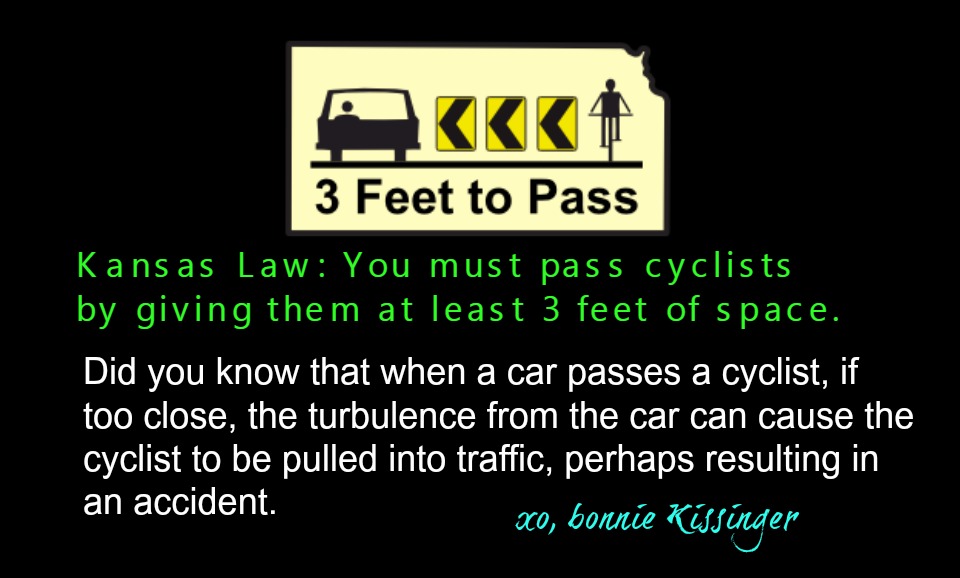

 Hearing those words as you run down the shoot… it’s an indescribable experience. It’s like an orgasm, but way better!
Hearing those words as you run down the shoot… it’s an indescribable experience. It’s like an orgasm, but way better!

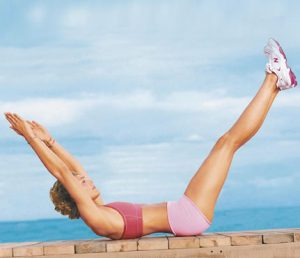 The first exercise is what I refer to as the Jack Knife sit-up. Lay on your back. Hands and feet meet in the center. Slowly extend arms and legs away from center of body. Don’t touch floor with arms or feet. Hold and bring back to center. Do these for 1 minute. Try to do 25-30 reps. If you are a beginner, bend the knees and bring them up to midline and back down.
The first exercise is what I refer to as the Jack Knife sit-up. Lay on your back. Hands and feet meet in the center. Slowly extend arms and legs away from center of body. Don’t touch floor with arms or feet. Hold and bring back to center. Do these for 1 minute. Try to do 25-30 reps. If you are a beginner, bend the knees and bring them up to midline and back down.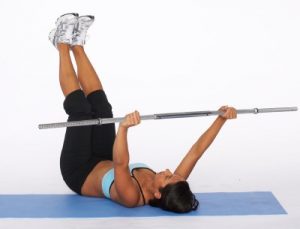 Leg extension with a workout bar is to use a bar and hold the bar in front of you and just lower the legs while keeping the hands and workout bar in place overhead at waist level. Drop legs 6” from floor, hold then bring back up to the bar. If you don’t have a bar, place hands under lower back and lower legs to floor, approximately 6” from the floor and back up to mid-line. Do each exercise for 1 minute/rest for 1 minute.
Leg extension with a workout bar is to use a bar and hold the bar in front of you and just lower the legs while keeping the hands and workout bar in place overhead at waist level. Drop legs 6” from floor, hold then bring back up to the bar. If you don’t have a bar, place hands under lower back and lower legs to floor, approximately 6” from the floor and back up to mid-line. Do each exercise for 1 minute/rest for 1 minute. Now take the same bar and alternate it from side to side in order to work the oblique.
Now take the same bar and alternate it from side to side in order to work the oblique.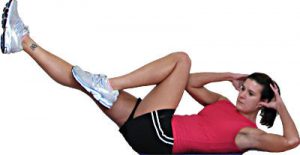 Another great abdominal exercise you can do if you don’t have a bar is to simply do the Classic Scissor Crunch. Lay on floor, hands on head not behind head, so you can avoid pulling the neck and alternate legs to elbow. Right elbow to left knee and reverse, count that as 1 rep. What I refer to as a double count. Do for 1 minute. 25-30 reps.
Another great abdominal exercise you can do if you don’t have a bar is to simply do the Classic Scissor Crunch. Lay on floor, hands on head not behind head, so you can avoid pulling the neck and alternate legs to elbow. Right elbow to left knee and reverse, count that as 1 rep. What I refer to as a double count. Do for 1 minute. 25-30 reps.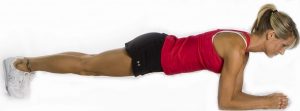 The next exercise is great for your whole core, The Classic Plank. When done with the scissor crunch, flip over on your mat, place hands under shoulders, lift lower body in straight line, flat back and hold for 1 minute.
The next exercise is great for your whole core, The Classic Plank. When done with the scissor crunch, flip over on your mat, place hands under shoulders, lift lower body in straight line, flat back and hold for 1 minute. The last one is the Classic Crunch. Lay down on your mat, knees bent, hands on head so you don’t pull the neck, lift ½ way and back down, repeat. Complete as many as you can in 1 minute.
The last one is the Classic Crunch. Lay down on your mat, knees bent, hands on head so you don’t pull the neck, lift ½ way and back down, repeat. Complete as many as you can in 1 minute.